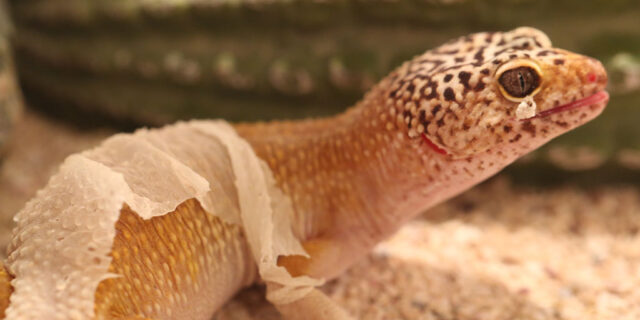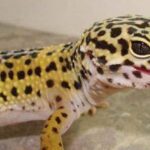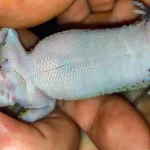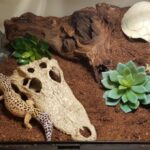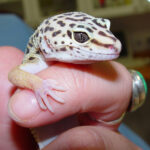Abnormal skin shedding in Leopard geckos (also known as dysecdysis) is usually an indication that something else is wrong. This post discusses what abnormal skin shedding looks like in Leopard geckos and point out its most common reasons.
Leopard geckos shed the outer parts of their skin as they grow. Skin shedding (also called ecdysis or molting) is seen from time to time and is more frequent in baby and juvenile Leopard geckos.
Table of Contents
Normal skin shedding in Leopard geckos
During the shedding process, the skin will turn white to grey after which pieces will start to become loose and peel off. Normally, Leopard geckos will shed their skins in one, large, complete piece. It is also normal for Leopard geckos to eat their sloughed skins in the process. The frequency at which Leopard geckos shed their skins is more or less dependent on the rate at which they grow. Adult Leopard geckos will shed approximately every 4 to 5 weeks and the skin shedding process should take a couple of hours at most. Also see Leopard gecko skin shedding for more information.
Normal behavioral changes before, during and after the shedding process include the following:
- Agitation, sometimes leading to biting behavior
- Lethargy in the form of moving slower, or moving less
- Hiding and spending more time in the hide box
- Anorexia (no or reduced appetite)
- Soaking in the water dish (also see soaking behavior in Leopard geckos for more information).
By keeping records, normal patterns, frequencies and duration, of your own Leopard gecko’s skin shedding can be archived and monitored for abnormalities.
Abnormal skin shedding in Leopard geckos
Abnormal skin shedding (dysecdysis) in Leopard geckos is evident by one or more of the following:
- Prolonged skin shedding (taking more than a day or two from when skin peeling starts)
- Partial shedding, i.e. the skin is peeling off in multiple small pieces and some pieces still stay behind on the body.
- Prolonged periods between one skin shed to the next
- Excessive time spent in the water container
Skin shedding problems in Leopard geckos can be due to various factors. Most shedding problems occur when there is a deviation in the main environmental factors. Other contributing factors include age, skin infections, Leopard gecko parasites, stress, injuries and excessive handling during the shedding period. Abnormal skin shedding is also often the result of health problems such as hypovitaminosis A.
Common environmental reasons for dysecdysis include incorrect temperatures and incorrect humidity. Leopard geckos will thrive in temperatures of 25 – 30ºC / 77 – 90ºF with a drop to room temperature during the evenings. Temperatures can be measured using a thermometer.
When the environmental temperature is too low, it can lead to chronic stress, retarded growth and diseases. The humidity is probably the single factor leading to most Leopard gecko shedding problems. A low humidity (i.e. a too dry environment) prevents old skin from loosening properly, leading to pieces remaining stuck on the body.
Potential complications from shedding problems
Abnormal skin shedding in Leopard geckos does not go without potential problems. A major problem includes the constriction of toes, parts of the tail, legs and feet. Unsloughed skin that remains in these areas has a restriction effect (almost like a tourniquet) due to the expansion of the area underneath. Areas/extremities distal to constrictions are deprived of normal blood flow and are ultimately at risk for tissue necrosis and detachment.
Leopard gecko foot missing multiple toes due to skin constrictions.
Another complication due to dysecdysis in Leopard geckos is secondary skin, mouth and eye infections. Retained skin can serve as growing sites for various bacteria.
How to treat skin shedding problems in Leopard geckos
In Leopard geckos, dysecdysis is almost always the consequence of other problems. Identifying these problems is often more important than identifying the shedding problem itself.
Immediate home management includes increasing the humidity by either increasing the size of the water bowl and/or adding a hide box with a moist substrate. If you already have a hide box, make sure that the substrate is fresh and moist. Starting when the skin turns dull, the shedding process of Leopard geckos can also be helped by daily gentle misting of the enclosure and daily lukewarm baths in a shallow container. If the shedding problems persist, reoccurs and/or there are already pieces of skin stuck to the body, professional help is indicated.
Leopard geckos with shedding problems should be evaluated by a reptile friendly veterinarian. The treatment of Leopard gecko shedding problems is threefold, namely to remove the remaining skin, to treat the underlying cause and to treat the complications.

